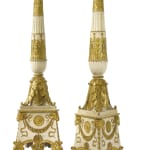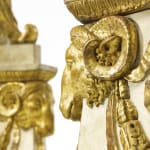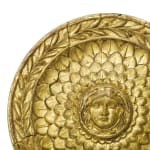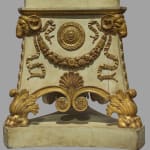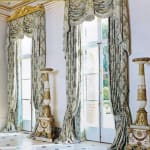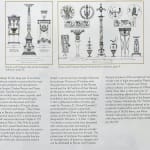Charles Percier and Pierre François-Léonard Fontaine (after)
Further images
Provenance
Didier Aaron, Paris.
"The Collection of Suzannne Saperstein", ‘Fleur-de-Lys’, Beverly Hills, California. Sotheby's Auction, New York, 19 April 2012.
Literature
Olivier Lefeuel, “Percier et Fontaine” in “Connaissance des Arts”, Paris, 15th June 1954, no. 28, p. 35, illustrating a page from a set of designs by Charles Percier and Pierre François Léonard Fontaine for the Russian Tsar of work in the Louvre and Tuileries, showing a woman’s bedroom with a torchère of comparable overall form. Pierre Arizzoli-Clémentel, “The Percier and Biennais Albums in the Musée des Arts Décoratifs, Paris”, in the “Burlington Magazine”, March 1998, p. 197, pl. 55, illustrating a design for a related candelabrum by Charles Percier for the Empress Josèphine in the Musée des Arts Décoratifs, Paris.
A magnificent pair of large Empire parcel-gilt white painted and carved torchères after a design by Charles Percier and Pierre François-Léonard Fontaine, each headed by a fluted and acanthus wrapped circular dish supported upon a stop-fluted baluster stem decorated with acanthus, tessellated stiff leafs and anthemion bands above acanthus volutes upon a tripartite plinth headed by ram’s heads at each corner from which suspend ribbon-tied floral and foliate wreaths centred above by an ornate Medusa mask head medallion above scrolls and anthemion along the shaped lower edge on acanthus wrapped paw feet, upon a tripartite base with canted corners
Paris, date circa 1810
Height 235 cm, width 76.5 cm, depth 76.5 cm.
The design for these imposing and very fine quality torchères was almost certainly conceived by the most celebrated Empire architects and ornemanistes Charles Percier (1764-1838) and Pierre-François-Léonard Fontaine (1762-1853). In addition to designs cited above they relate to a number of proposals for torchères illustrated in their Recueil de Décorations Intérieures, first published in 1801. Among them was a design for a giltwood torchère of similar size that has an identical upper section as the ones here, while a further plate shows another torchère with a very similar base to include ram’s heads, volutes and acanthus headed paw feet. In another design by Percier of 1798 (in the Musée des Beaux-Arts, Rennes) for a clock case features a similarly shaped base headed at the top angles by ram’s heads and centred along the lower edge by anthemion between sphinxes at the corners. (illustrated in Hans Ottomeyer and Peter Pröschel, “Vergoldete Bronzen”, 1986, p. 342, pl. 5.5.3).
As architects and ornemanistes Percier and Fontaine’s designs were instrumental in shaping the Empire style for Napoleon Bonaparte and in turn had a profound impact on other contemporary artists and craftsmen. As here their designs drew on different stylistic elements, predominantly from Antiquity that together made up the Empire style. The overall influence here is ancient Roman artefacts; in particular the resent torchères relate to Bacchic candelabra from the 2nd century AD such as one which was excavated near Naples in 1777 and sent to Paris in 1798, which was of similar overall form and featured the same fluted lobes, an acanthus clad base and tessellated foliate banding.
Among related torchères of similarly large size are a set of eight made in gilt wood by the Parisian ébéniste Pierre-Benoît Marcion (1769-1840), made circa 1810 for the Tuileries (illustrated in Denise Ledoux-Lebard, “Le Mobilier Français du XIXe Siècle”, 2000, p. 465). In addition a pair in gilt bronze by the preeminent bronzier Pierre-Philippe Thomire (1751-1843) was delivered in 1811 to the Grand Cabinet of the Emperor in the Tuileries. Interestingly those torchères were originally intended to be executed in giltwood by the celebrated firm of ébénistes Jacob-Desmalter et Cie at a cost of 78,000 francs (as discussed in Pierre Arizzoli-Clémentel “Le Mobilier de Versailles, Chef-d’Oeuvre de XIXe Siècle”, 2009, pp. 262-265).






